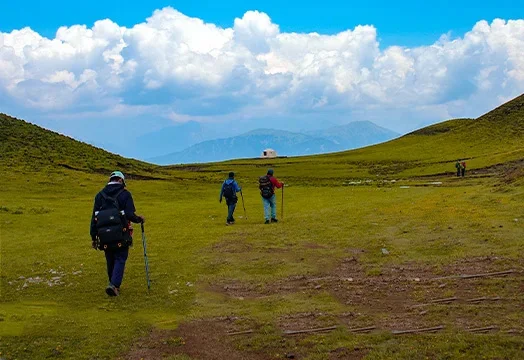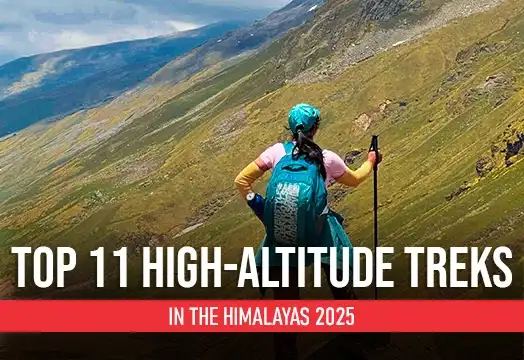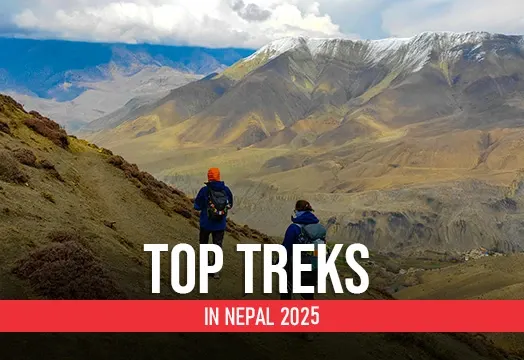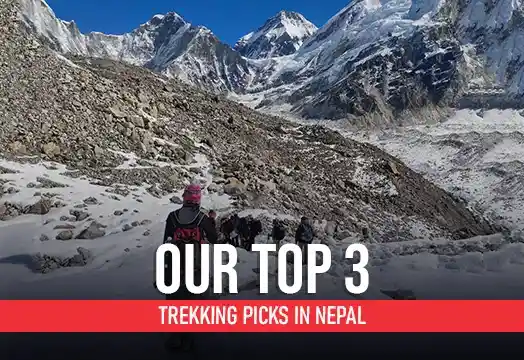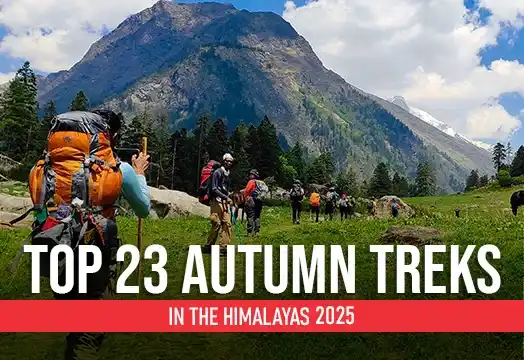Annapurna Base Camp Trek

Region
Pokhara | Nepal

Duration
9 Days

Max Altitude
13550 Ft.

Trekking Km
70 KM

Grade
Moderate
Get in Touch with Our Trek Expert
91 7351523841 info@trekthehimalayas.comMonday - Saturday: 10 AM to 09.30 PM (GMT +5:30)
Sunday: 10 AM to 05.30 PM (GMT +5:30)
37500 /Person
- March-2026
- April-2026
- May-2026
- June-2026
- USD 520 for Non-Indians and OCI card holders
- 5% GST will be applicable on Trek Cost and Add-ons
- Services from Pokhara to Pokhara.
- 2 Night Stay at Pokhara is included
- All Meals are included from Klue to Jhinnu
- Farewell Lunch in Pokhara
- Transportation from Pokhara to Pokhara.
Add-ons
Offload 7500
- Backpack offload is optional
- Choose add-ons during booking. If missed, log in and add them later.
- Book offload at least 10 days before the trek.
- For offline bookings at the base camp, a convenience fee of Rs. 8500 applies.
- In the event that you choose to cancel your trek prior to the departure date, you will receive a full refund.
- + 5% GST will be applicable
Get in Touch with Our Trek Expert
91 7351523841info@trekthehimalayas.com
Monday - Saturday: 10 AM to 06 PM (GMT +5:30)
Overview
Trek Name: Annapurna Base Camp Trek
Days: 9
Adventure Type: Trekking
Base Camp: Pokhara
Season:Spring | Summer | Autumn |
Month:March | April | May | October |
Country: Nepal
Altitude: 13550 Ft.
Grade: Moderate
Rail Head: -
Stay: Hotel & Teahouse
Food: Meals while on trek & at Hotel/Guesthouse (Veg & Eggs)
Location: Pokhara
Distance: 70 Km.
Trail Type: Point to point trail | Camping at the same location upon returning.
AirPort: Pokhara International Airport
Highlights:
- USD 520 for Non-Indians and OCI card holders
- 5% GST will be applicable on Trek Cost and Add-ons
- Services from Pokhara to Pokhara.
- 2 Night Stay at Pokhara is included
- All Meals are included from Klue to Jhinnu
- Farewell Lunch in Pokhara
- Transportation from Pokhara to Pokhara.
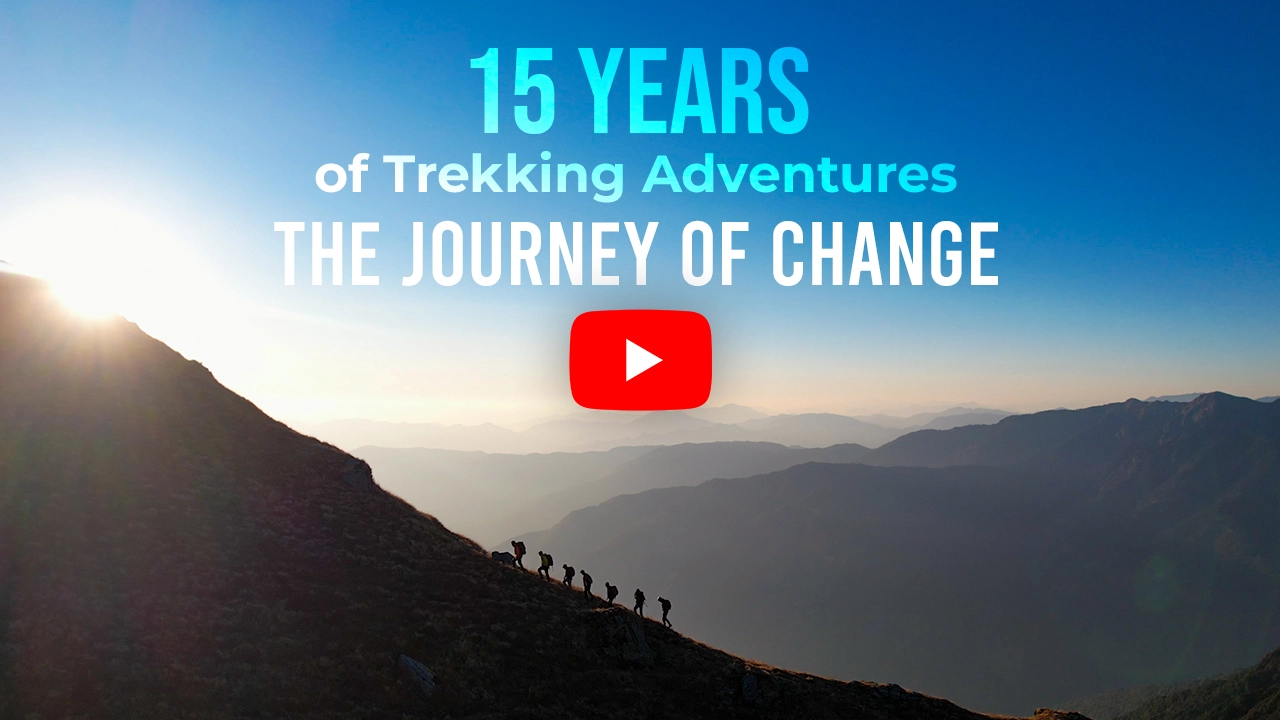
Why is Annapurna Base Camp a Must-Do Trek ?
- The Annapurna Base Camp trek takes you on an unforgettable journey to the foot of the majestic Annapurna mountain, while also taking you through the breathtaking base of Machhapuchhare, the iconic "Fishtail" peak.
- ABC is one of the best treks in Nepal, that takes you through the Annapurna Conservation Area, offering you picturesque landscapes.
- Explore traditional villages along the trek to Annapurna Base, where you can experience their unique customs, age-old rituals, and heartfelt hospitality firsthand, making your journey even more enriching.
- The trek unfolds mesmerizing panoramic views of the Annapurna Massif, Khangsar Kang, Varahashikar, Tarke Kang, Machhapuchhare, Hiunchuli and a lot more. These peaks look even more enchanting during the sunrise and sunsets when they light up with alpenglow.
- Immerse yourself in the vibrant cultural heritage of Nepal by connecting with the warm and welcoming locals, primarily from the Gurung and Magar communities.
- Enjoy the therapeutic benefits of the geothermal waters from the natural hot springs at Jhinu Danda.
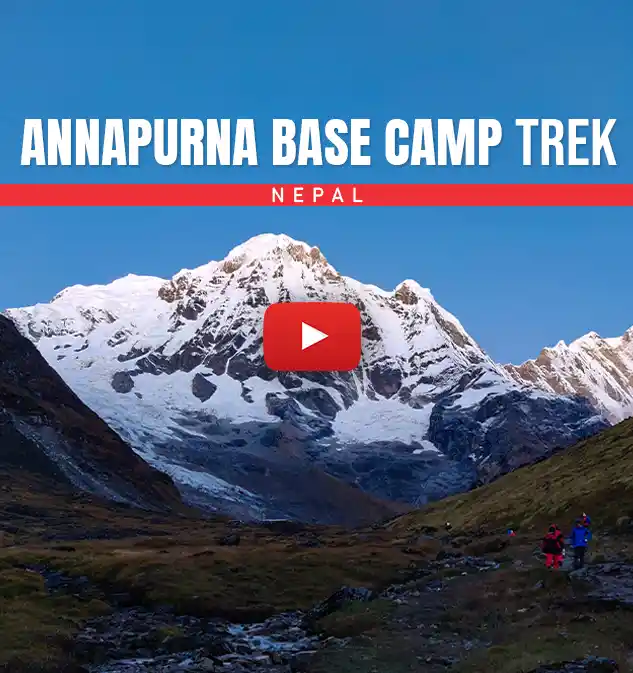
Who Can Participate
- Age Requirement:
- Minimum 12 years
- First-timers are welcome, though prior trekking experience is preferred. Good fitness is a must.
- Fitness Criteria:
- If the trekker wants to carry a backpack then he/she should be able to carry a 10-12 kg backpack. If opt Off-load option then the trekker should be able to carry 3-5 kg backpack.
- If a trekker's BMI is more or less than the normal range (18-28), please consult our Trek Coordinator before booking.
Annapurna Base Camp Trek Itinerary
Arrival in Pokhara
- Altitude: 825 m/ 2,700 ft.
- Stay: in the hotel (check-in at 12 noon).
- Briefing about the trek in the evening.
- Sightseeing: Phewa Lake, Tal Barahi Temple, Himalayan Views, International Mountain Museum (not included in the cost).
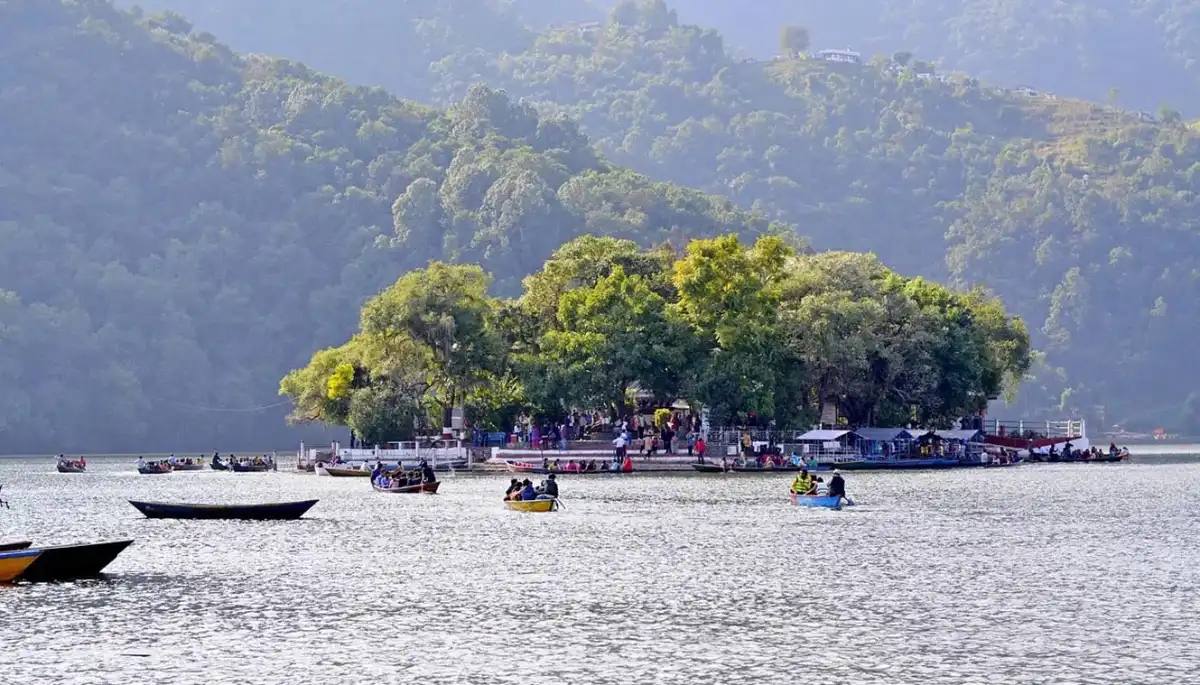
After a pleasant flight journey, arrive in Pokhara. It is the hub of mountaineers that lies on Phewa lake. All the big expeditions and trekking start from here. Snow-capped peaks surround the locality and you can see stunning views of the Annapurna Ranges. Enjoy the Himalayan views, rice fields, and Nepalese culture around. If you didn’t know, Pokhara used to be a trade route between India and Tibet some 300 years ago. You may also spot paragliders soaring above the city. The tranquil setting of Pokhara gives you a wonderful opportunity to reconnect with nature.
In the evening you can go sightseeing around the local attractions in Pokhara like the Phewa Lake, Tal Barahi Temple, and International Mountain Museum. You will also receive a briefing from our team regarding the schedule of upcoming and everything entailed in the trek. Your trekking day starts tomorrow and it's a long journey ahead so rest well so that you are fresh and energized for tomorrow.
Pokhara to Klue (Drive) and trek to Ghandruk
- Altitude Ghandruk: 2,000 m/ 6,500 ft.
- Altitude (Klue): 1,300 m/ 4,300 ft.
- Pick-up time: 7:00 am.
- Drive to Klue: 48 km | around 2 hrs.
- Trek Distance: 7 km | Duration 4-5 hrs.
- Gradual ascend throughout.
- Water source: Villages and teahouses on the route.
- Views: Machapuchhare and Annapurna (South), Hinchuli, Gangapurna, and Annapurna - 3.
- Visit the Old Gurung Museum in the evening.
- Lunch on the way.
- Stay: at teahouses.
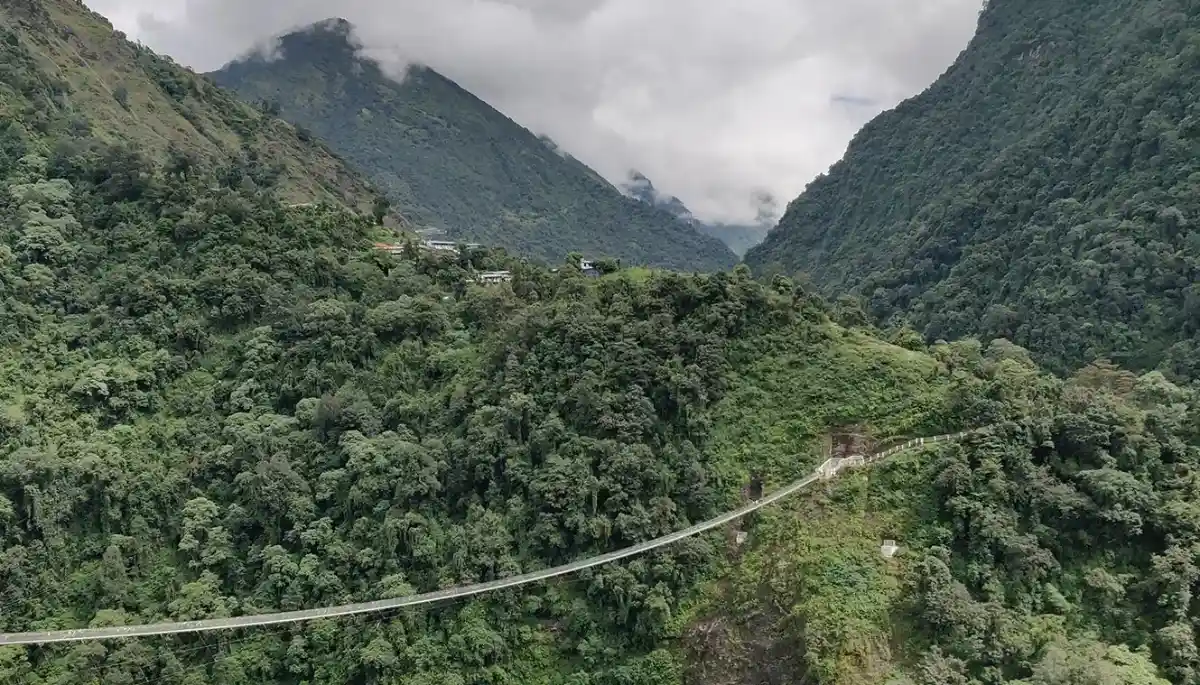
After breakfast, you will have a ride of approximately 2 hrs to Klue. The actual trekking begins henceforth to Ghandruk crossing Lower Ghandruk. The path is well paved having stairs intermittently. The trek has a gradual ascent taking 4-5 hours to reach our camping site. Once you cross the bridge over the Bhurgundi River on your way to Ghandruk, you will arrive at Birethanti where you are required to sign documents as part of formalities with the local authorities for the Annapurna Base Camp Trekking. Post this the trek begins to ascend towards Ghandruk.
From here, you will have to climb some stone steps to Kimche. After the stairs, the gradient of the road eases out a bit. From here it will take about 2 hours to reach Ghandruk. Ghandruk is considered the biggest village on the trek route. It is inhabited by stone-built small houses. The village is loaded with tea houses that serve typical Nepalese cuisine. The village also has a local museum that showcases the Gurung culture. In the south, you can notice Machapuchhare and Annapurna views on a clear day. Relax in your bed for a wonderful night in the mountains.
Ghandruk To Chhomrong
- Altitude: 2,200 m/ 7,200 ft.
- Trek Distance: 10 km | 6-7 hrs.
- First 1-hour ascent then descent till lunch point followed by an uphill climb to Chhomorong.
- Water source: Teahouses on the way.
- Views: Annapurna (South), Gangapurna, Fishtail, Hinchuli, and Annapurna 3, amazing sunset view on sunset on Annapurna Mountain Range.
- Chhomorong market is the last market on this trek after this no market is available.
- Lunch on the way.
- Stay at tea houses.
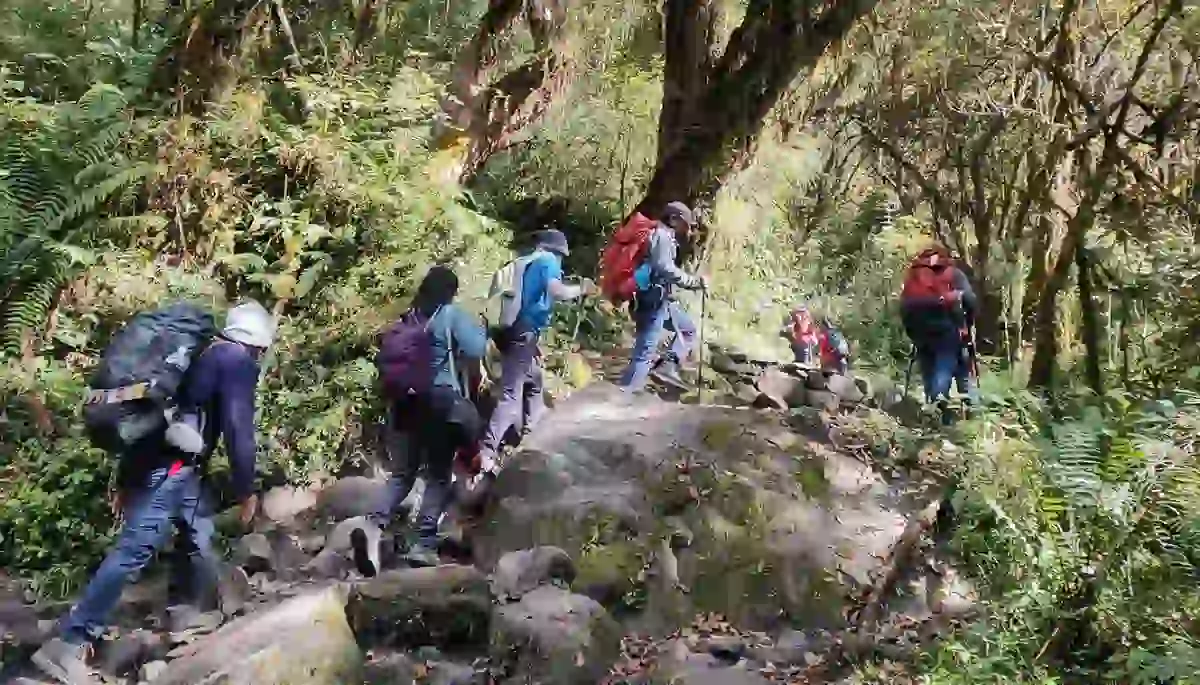
The hike today is through a delightful muddy trail laid up with scenic villages on both sides. After a descent of 1 hour, you will reach Kimrong Khola. Kimrong is a small village located on the top of a ridge offering panoramic views of the Himalayan mountains all around. A beautiful array of snow-covered peaks, Annapurna South, Gangapurna, Fishtail, and Hinchuli, begin to appear. From Kimrong, you have to descend about 400 m sharply to Kimrong Khola, through dense covers of Oak and Rhododendron trees. The route henceforth goes uphill until Chhomrong (a 4-5 hours hike). Chhomrong is situated at the base of the Hiunchuli mountains and you will see picture-perfect hilly settlements surrounded by green banana fields, rhododendrons, ferns, etc., throughout. Chhomrong lies on a hilltop having stone paved stairs. It is the gateway to Annapurna Sanctuary and permits are granted here. You can also see Sinuwa Village on the opposite side of the mountain. The sights of Annapurna South become prominent. Again there are numerous tea houses and shops selling batteries, memory cards, and other accessories. Watch the peaceful sunset on the Annapurna range and rest for the day.
Chhomrong To Bamboo
- Altitude: 2,300 m/ 7,600 ft.
- Trek Distance: 10 km | 5-6 hrs.
- Descend on stone steps to Chomrung Khola, then steeply ascend to Sinwa to Bamboo village.
- Water source: Teahouses on the way.
- No mountain view in Bamboo.
- Lunch on the way in teahouses.
- Bamboo is full of Bamboo trees.
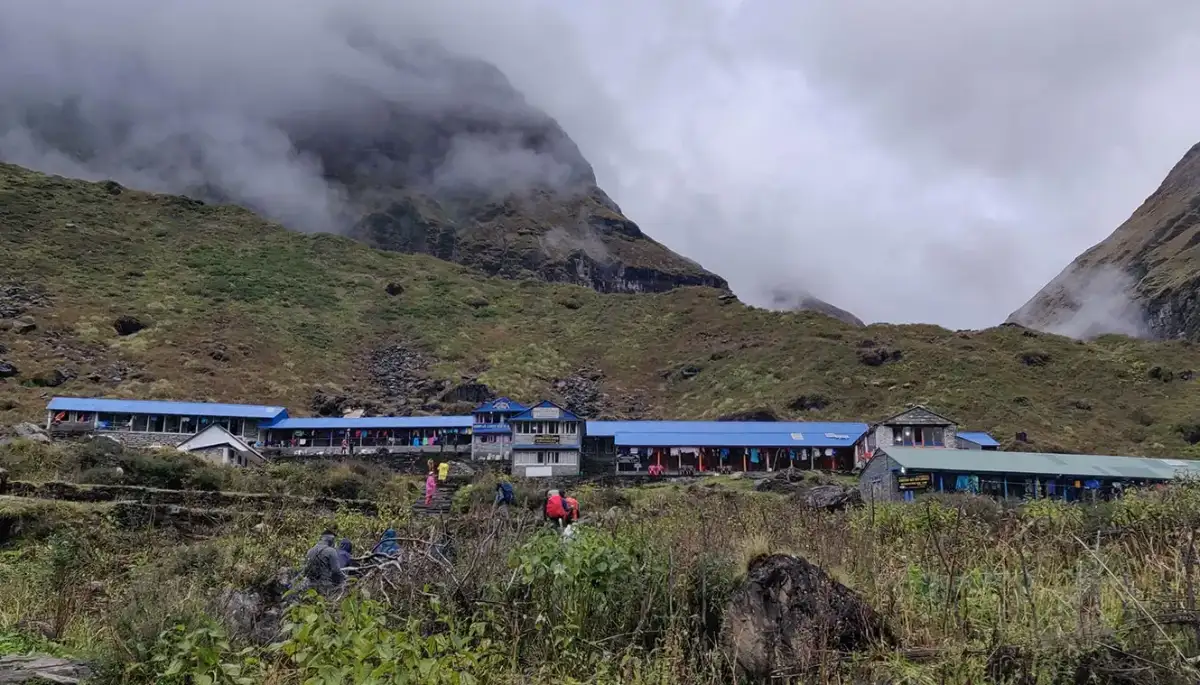
Welcome another amazing morning in the lush green hilly setup. Start with a descent on 2500 stone-built stairs leading to a bridge. The hanging bridge then takes you to Chomrung Khola, which seems like entering into dense forests. The Sanctuary is flourished with rhododendrons, oak, and alpine trees. Therefore the trail looks lush and adorned with reddish-pink flowers.
Climb up the stairs to the other side of the mountain to Sinuwa Village. Below, you can see the Chomorng River gushing away with a torrential force. The trail is steep to Sinuwa village. Sinuwa is marked with a few teahouses and lodges. It is enclosed between thin forest cover. Past these points, the donkeys are not permitted on the trail and the goods are then carried by the porters from this point on. Annapurna III comes into clear visibility here. Another climb opens to Kulidhar then a downhill hike ends at Bamboo camp.
The bamboo campsite does not offer as many mountain views as other teahouse stops as it is at a lower altitude than the surrounding mountains. However, you may see a lot of Bamboo plants around the campsite. Rest well in Bamboo and tomorrow we will make our way to the stunning Machapuchhare Base Camp.
Bamboo To Deurali
- Altitude: 3,200 m/ 10,550 ft.
- Trek Distance: 9 km | 5-6 hrs.
- Moderate level of ascent crossing Modi Khola River.
- Water source: Teahouses on the way.
- Views: Machhapuchhre, Gangapurna, and Annapurna III.
- Lunch is on the way.
- Stay in teahouses.
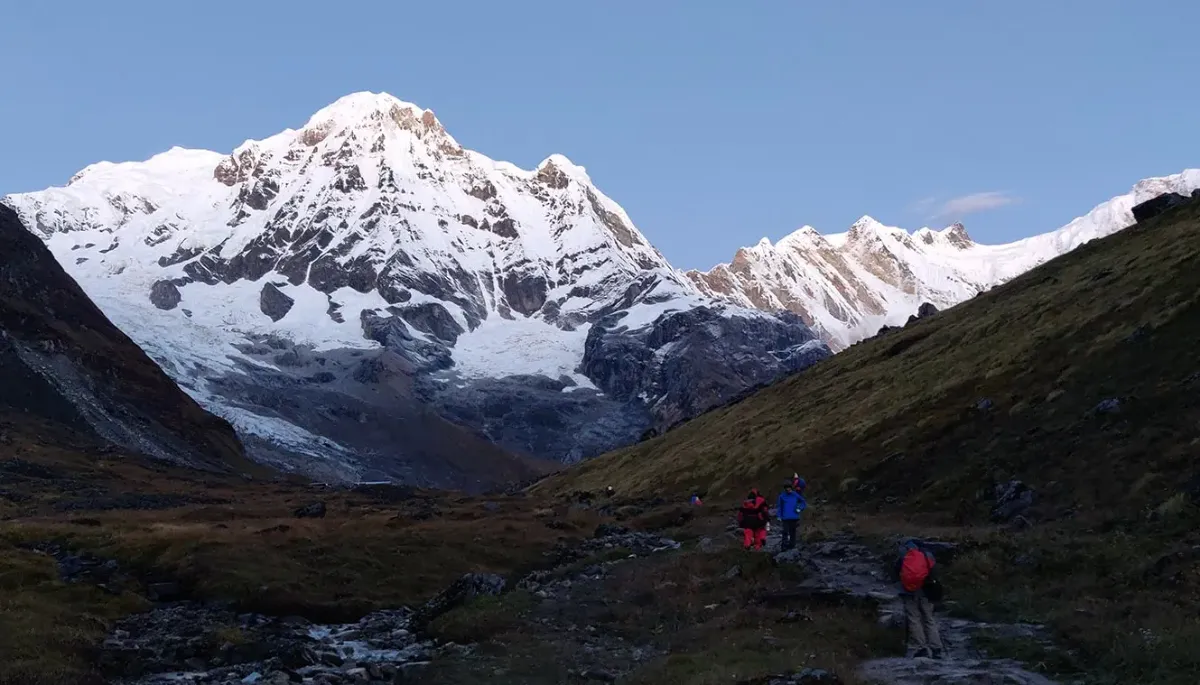
Get all braced with enough energy as this is the strenuous day of the trek. Yet, the trail will show changing vegetation from sub-tropical to alpine and the sights will keep you revitalized. The height gain is close to 3000 feet, therefore take it slow and stay hydrated. In one hour the first village Dovan comes en route, identified by 5 lodges only. The tip of Machapuchhare mountain will be visible. Mix path of gradual ascends and descends with muddy trail lead to Himalaya. A wooden bridge and shrine will be the highlight of the trail. Himalaya has quaint tea houses. After the Himalayas, the terrain sees a change from dense alpine forests to a bouldered region. You might see some vegetation like Bamboo, grass, and ferns.
A few landslide and avalanche-prone areas will be seen on the path ahead. An overhanging cave called Hinku arrives after an hour of hiking up. The entrance to the cave is blocked. The trail begins to descend for about 10 to 15 minutes from here. From here the trail descends for another 15 minutes until you arrive at two big snow patches. Cross the snow patches and a stream crossing followed by a climb of about 20 minutes to reach Deurali. This is the camping spot for the night. Deurali is surrounded by lush greenery and offers panoramic mountain sceneries. You can see the Machapuchhre, Gangapurna, and Annapurna III from here.
Deurali To Annapurna Base Camp Via Machhapuchhre Base Camp
- Altitude Annapurna Base Camp: 4,130 m/ 13,500 ft.
- Altitude Machhapuchhre Base Camp: 3,700 m/ 12,200 ft.
- Trek Distance: 8 km | 6 hr.
- Moderate ascent till Annapurna Base Camp.
- Water source: Teahouses on the way.
- Views: Entire Annapurna range, panoramic views of Gangapurna, Gandharvachuli, Machapuchare, Annapurna (South), and view of mighty Annapurna I, get fantastic 360-degree views and beautiful sunrise and sunset.
- Lunch at MBC.
- Stay: in teahouses.
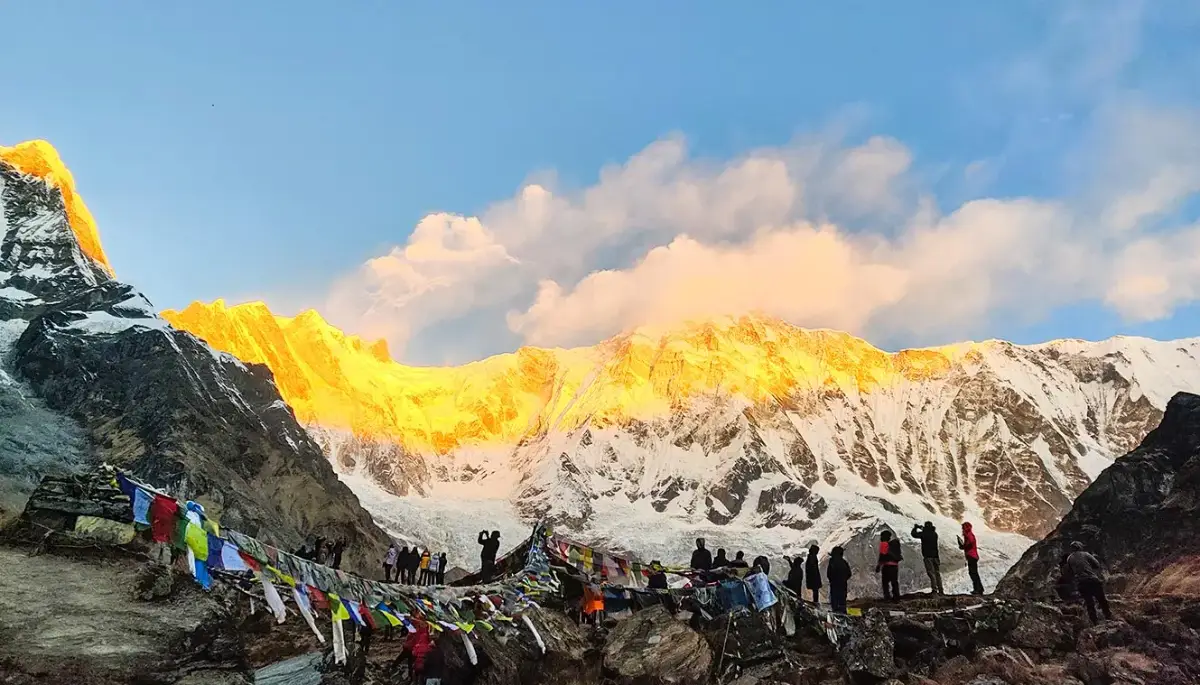
The trail that climbs out of Deurali is a bouldered section. From here the trail opens up to a valley with Modi Khola thundering past you. Another section of the rocky terrain of 40 minutes directs you to Bagar. From here, you will walk past some abandoned lodges, and in about one hour you will come across a bridge over Modi Khola, after crossing this bridge the next halt, Machapuchre Base Camp is 30 minutes away. Keep your eyes on the left and you will see astounding views of the Annapurna Ranges while in your front you will get to see the majestic Machapuchhare Range.
MBC is a stunning place well-known for the mesmerizing moon rise on Machapuchre mountain, do not miss this wonderful night sky. Along with it, other peaks seen are Mt. Hiunchuli, Annapurna South, Annapurna I, Annapurna III, Gandharvachuli, and Gangapurna. Since you will be climbing close to 3,000 ft today, so be aware of signs of AMS. The route takes a sharp 90-degree turn to the left for ABC. The initial trial has a steep ascend followed by a gradual ascend. You will be hiking above the tree line; hence no traces of trees will be seen.
Just as you get closer to the camp, the magnificent Annapurna I becomes bigger and bigger. The ABC is like being on an island encircled by giant peaks and huge never-ending ranges. 6000 and 8000 m peaks surround the base camp and it is an astounding sight to behold. 360-degree spectacles of the magnificent Annapurna range, Gangapurna, Gandharvachuli, and Machapuchare. Enjoy your lunch looking at the white clouds waving over these peaks. If you are lucky enough, you may even spot some Marmuts on your way to the campsite. Spend the rest of the day breathing with the mountains. Live every moment and sleep in their shelter.
https://trekthehimalayas.comAnnapurna Base Camp To Bamboo
- Altitude: 2,300 m/ 7,600 ft.
- Trek Distance: 13 km | 8-9 hrs.
- Retracing the route with gradual ascend and descend.
- Water source: Refill water bottles at teahouses
- Stay: in teahouses.
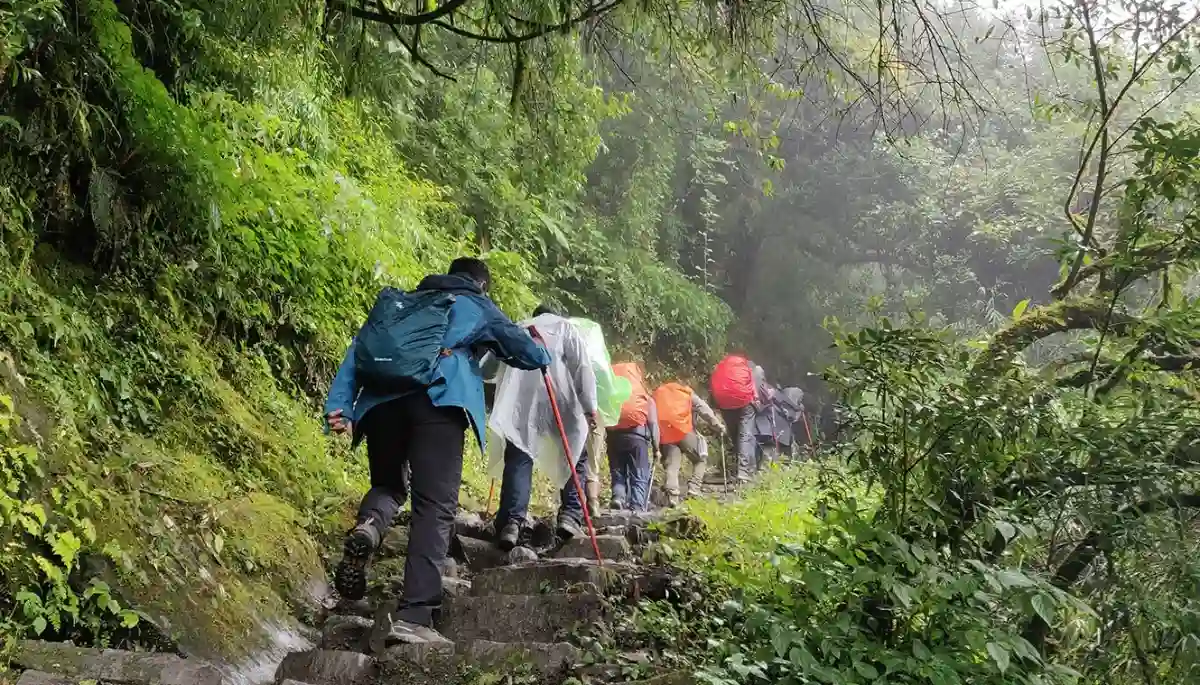
This is the longest day of the trek retracing the steps back to Bamboo. The trail as you know is mostly a descent so is quite easy. Wake up to an amazing sunrise over the Annapurna Massif. This is one of the best sunrises, you will see so try not to miss it. After watching a sunrise and a delicious breakfast, we will begin to head down towards Bamboo. The MBC, Deurali, Himalaya, and Dovan habitats will pop up again as you move down. Relax in your bed at Bamboo Lodge after a long day of walking.
Bamboo To Jhinu Hot Spring
- Altitude: 1,700 m/ 5,600 ft.
- Trek Distance: 8 km | 5-6 hrs.
- A mixture of steep ascending and descending trails.
- Water source: Refill water bottles at tea houses.
- Stay: at teahouses.
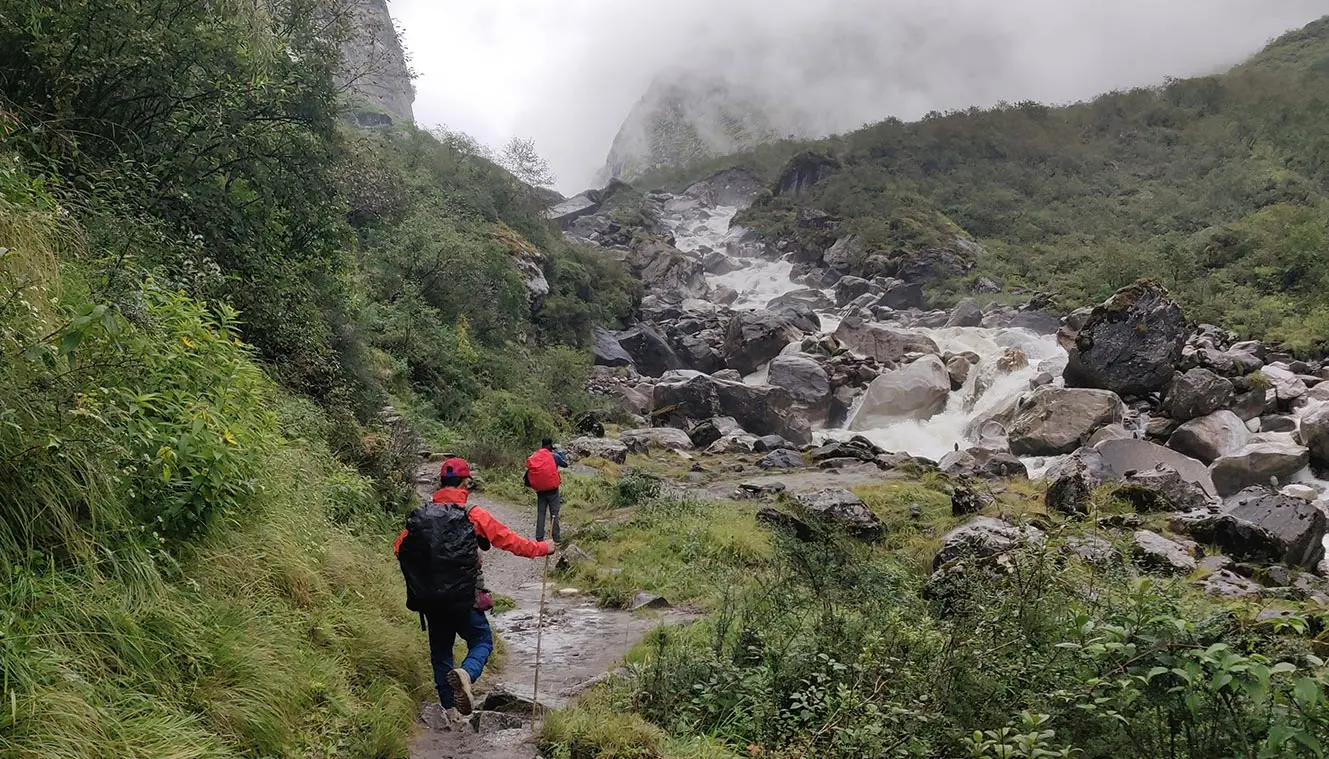
Again retrace your path to Sinuwa followed by a steep descent to Chomrung Khola. It should take around 45 minutes to reach Sinuwa. Cross the same hanging bridge towards Chomrung Khola. Another steep ascent will lead to Chomrung village. It will take about an hour to reach Chomrung Khola and 45 minutes more to Chomrung. Try to re-picture the sights you captured earlier and enjoy them.
From Chomrung take an ascending trail until you arrive at the fork where a signpost reads Jhinu. From here on, you have to take the steep descending steps, all the way, to Jhinu. It will take you around 1.5 hrs to reach Jhinu.
With downhill and then uphill hike Jhinu Danda settlement arrives. Jhinu is popular for its hot springs and you will see a lot of subtropical forests all around. Enjoy the refreshing hot springs of Jhinu 20 minutes away. Cherish your last night of the trek.
Jhinnu Hot Spring To Jhinnu Bridge And Drive To Pokhara
- Altitude Jhinnu Bridge: 1,700 m/ 5,600 ft.
- Trek Distance: 2 km | 45 minutes.
- Drive Distance: 60 km | 3 hrs.
- Easy trail to road-head, from road-head drive to Pokhara.
- Check-in at the hotel in Pokhara.
- Debriefing and certificate distribution in the evening.
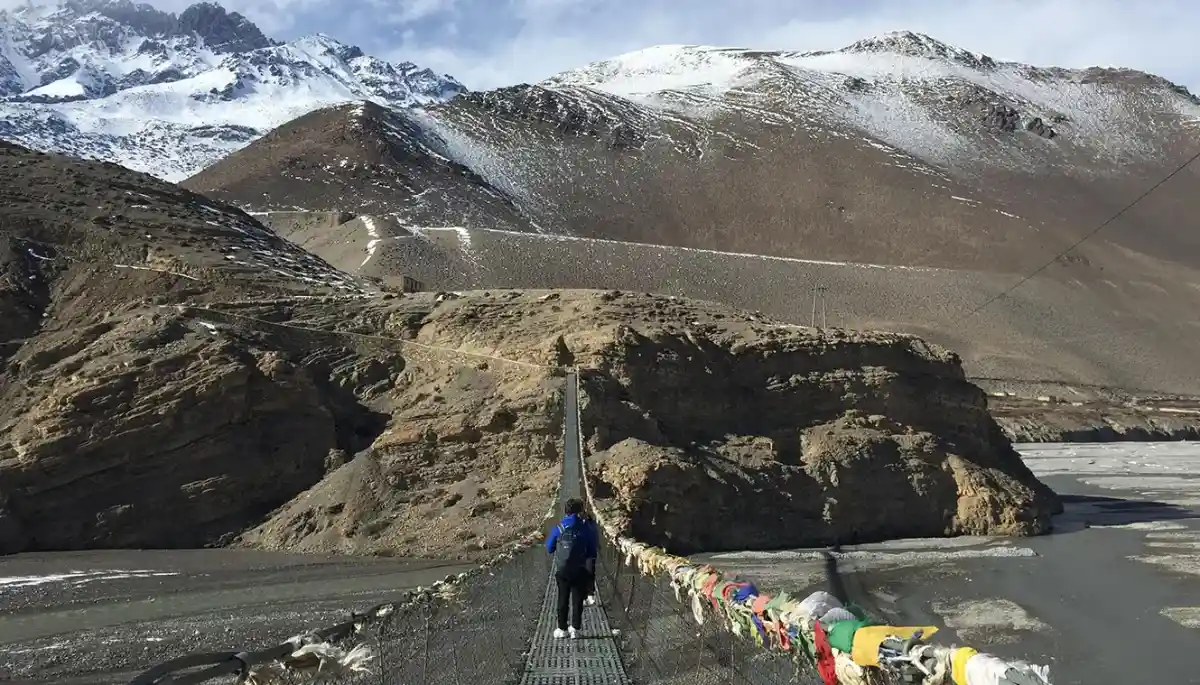
From Jhinnu Hot Spring follow the descending trail to Kimrong Khola Bridge. It will take about 45 minutes. Keep walking on the trail along the houses and you will arrive at a roadhead. From here, you will board a vehicle to Pokhara. In about 3 hours you will reach your hotel in Pokhara. Spend the evening at your leisure in Pokhara. Your overnight accommodation is arranged in Pokhara as well.
Note:
- Checkout time of the hotel is 10:30 am on day 10.
- It is advisable to make any further travel plan on day 10 or after day 10.
- Keep 1-2 buffer days in your travel plan.
- If buffer days are not used in the travel then it can be used to Explore Pokhra.
- Distance, Altitude, and Trekking hours are approximate and rounded off.
- Keep the original and copy of ID proof handy.
Day-1: Arrival in Pokhara
- Altitude: 825 m/ 2,700 ft.
- Stay: in the hotel (check-in at 12 noon).
Day-2: Pokhara to Klue (Drive) and trek to Ghandruk
- Altitude Ghandruk: 2,000 m/ 6,500 ft.
- Altitude(Klue): 1,800 m/ 6,000 ft.
- Drive to Klue: 48 km | around 2 hrs.
- Trek Distance: 7 km | Duration 4-5 hrs.
Day-3: Ghandruk To Chhomrong
- Altitude: 2,200 m/ 7,200 ft.
- Trek Distance: 10 km | 6-7 hrs.
Day-4: Chhomrong To Bamboo
- Altitude: 2,300 m/ 7,600 ft.
- Trek Distance: 10 km | 5-6 hrs.
Day-5: Bamboo To Deurali
- Altitude: 3,200 m/ 10,550 ft.
- Trek Distance: 9 km | 5-6 hrs.
Day-6: Deurali To Annapurna Base Camp Via Machhapuchhre Base Camp
- Altitude Annapurna Base Camp: 4,130 m/ 13,500 ft.
- Altitude Machhapuchhre Base Camp: 3,700 m/ 12,200 ft.
- Trek Distance: 8 km | 6 hr.
Day-7: Annapurna Base Camp To Bamboo
- Altitude: 2,300 m/ 7,600 ft.
- Trek Distance: 13 km | 8-9 hrs.
Day-8: Bamboo To Jhinu Hot Spring
- Altitude: 1,700 m/ 5,600 ft.
- Trek Distance: 8 km | 5-6 hrs.
Day-9: Jhinnu Hot Spring To Jhinnu Bridge And Drive To Pokhara
- Altitude Jhinnu Bridge: 1,700 m/ 5,600 ft.
- Trek Distance: 2 km | 45 minutes.
- Drive Distance: 60 km | 3 hrs.
Note:
- Checkout time of the hotel is 12:00 Noon on day 10.
- It is advisable to make any further travel plans on day 10 or after day 10.
- Keep 1-2 buffer days in your travel plan.
- If buffer days are not used in the travel then it can be used to explore Pokhra.
- Distance, Altitude, and Trekking hours are approximate and rounded off.
- Keep the original and copy of ID proof handy.
Annapurna Base Camp Trek Graph
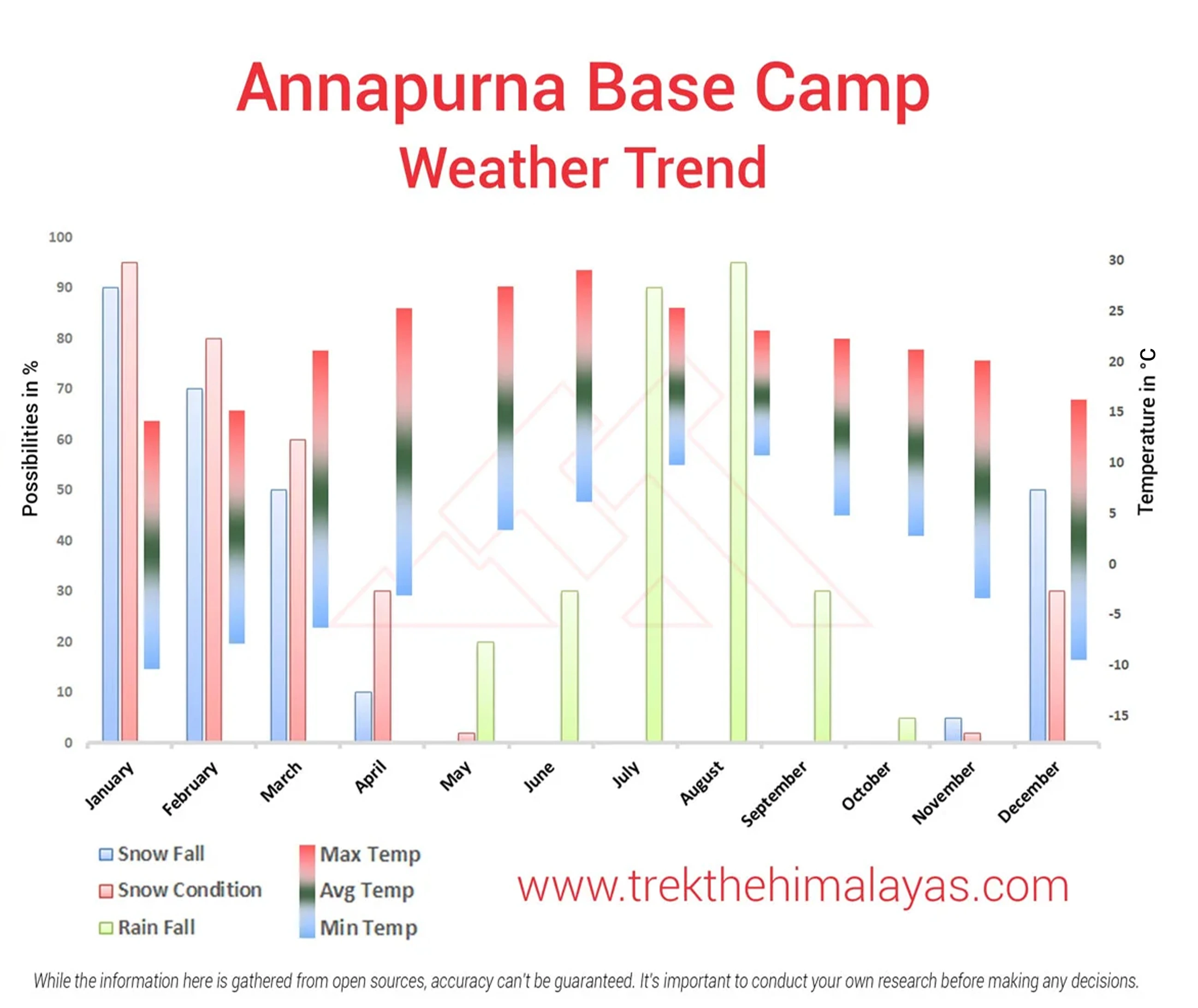
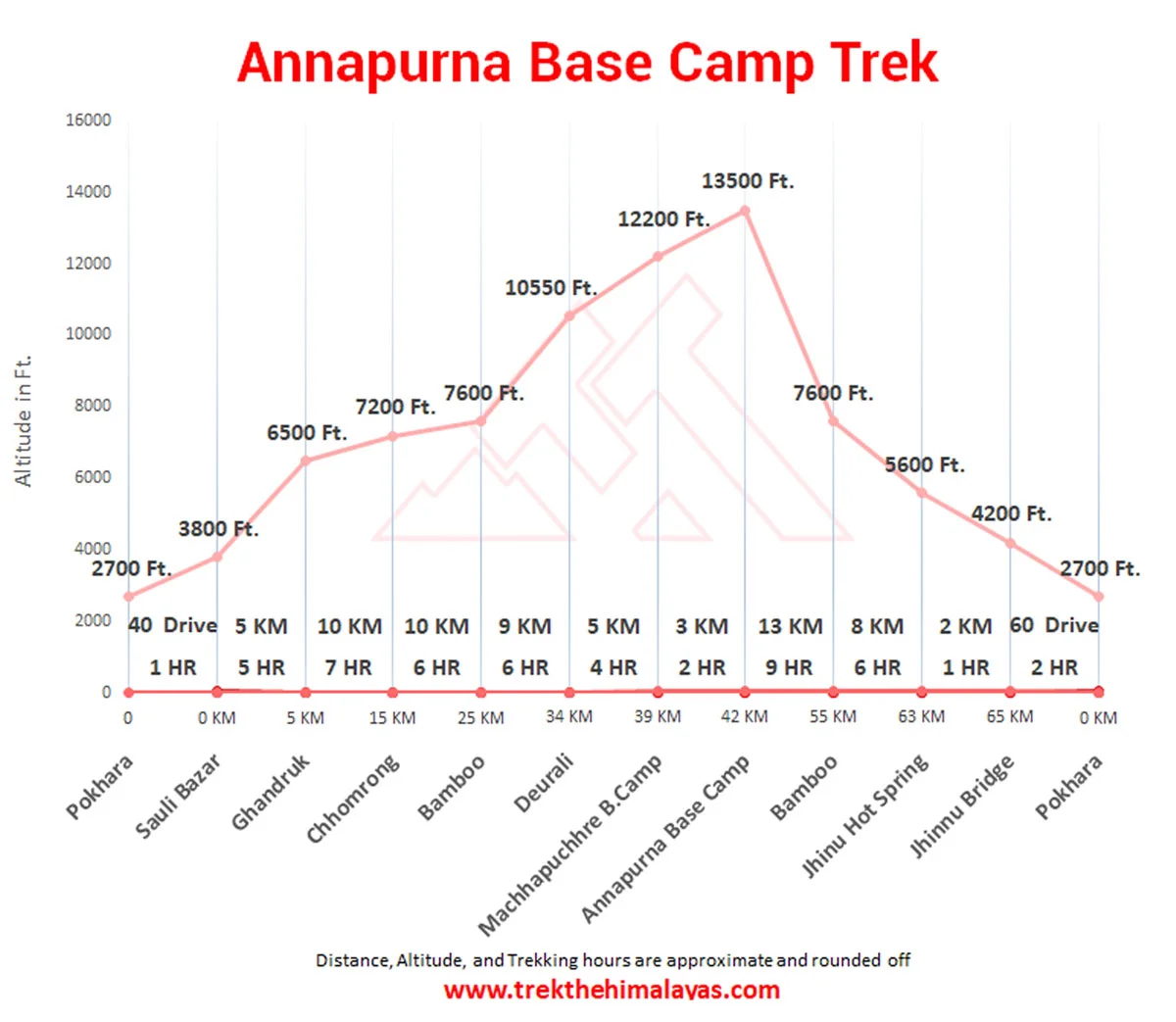
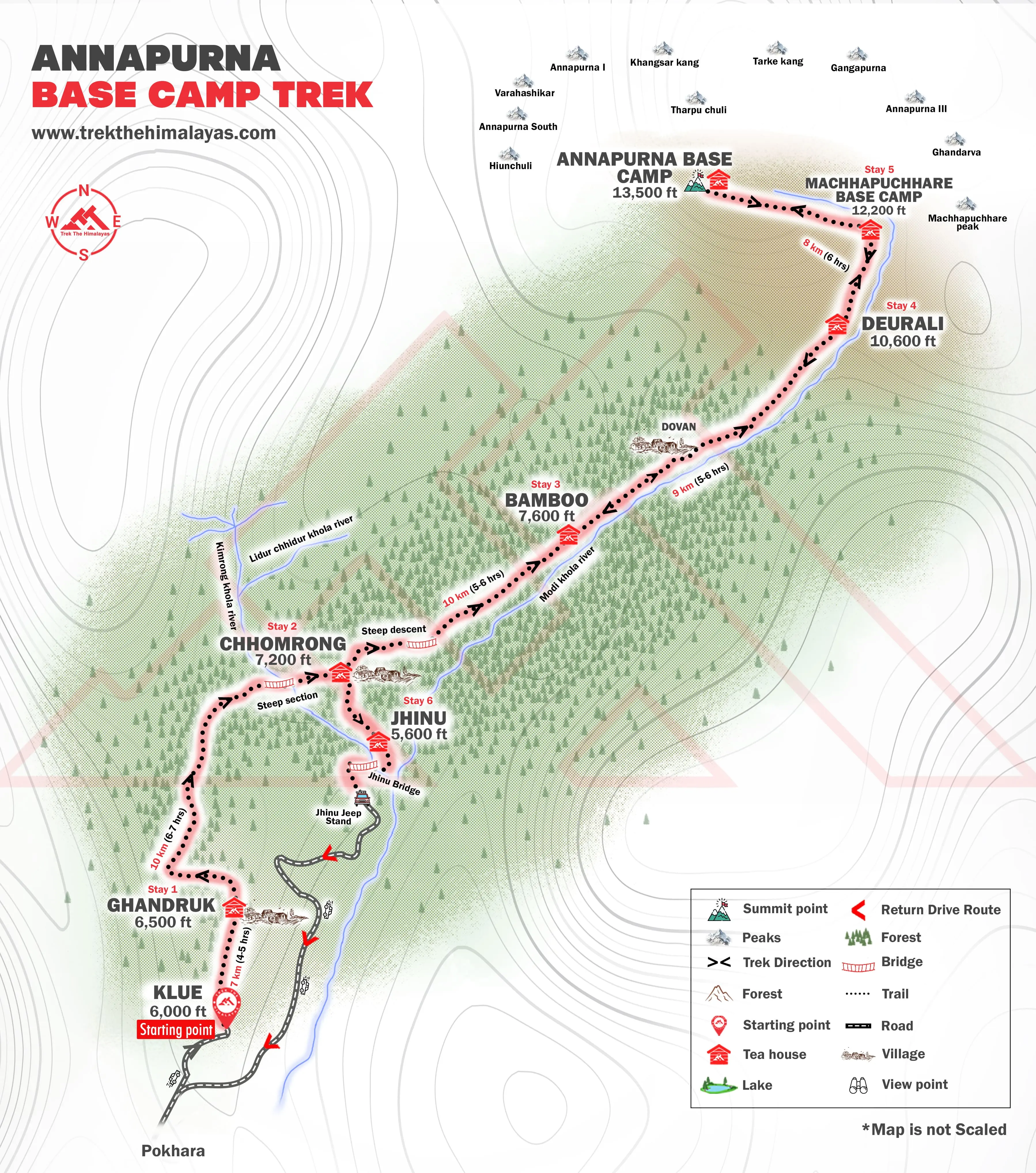
- Pulse rate at rest must be in between (60 to 100 beats per minute).
- Blood Pressure Reading must be in between (DIASTOLIC 75 – 85, SYSTOLIC 100 - 130 mm Hg).
- Respiratory rate at rest must be in between (12 to 20 breaths per minute).
- Should not have Liver and kidney issues.
- Should not have Diabetes Mellitus, Bronchial Asthma, Heart problems, Hypertension, etc.
- No pacemaker implant.
- People with Sinus issues, Epilepsy please contact to trek coordinator before booking the trek.
- If your BMI is not normal, Please contact our Trek coordinator before Trek booking.
Medical & Disclaimer Form (Mandatory Documents) Click here to download Medical & Disclaimer Form
- Junior trekkers (below 15 years) should have a company of parents/guardians.
- Trekkers between 15 to 18 years can come solo with the disclaimer form signed by parent/guardian.
- Medical & Disclaimer Form (Mandatory Documents) Click here to download Medical & Disclaimer Form
Important Links
- Mandatory Documents to Bring on A Trek Click Here.
- How to pay Add-ons, Submit Medical Forms, and Dietary Preferences Click Here to watch Video
How To Reach
Pick-Up Information
- It is essential for everyone to arrive at Pokhara (1:00 pm).
- Upon booking the trek, you are required to come to our hotel. Your trek coordinator will provide you with details such as the name of the Pokhra hotel, its location, and the contact person's number.
Options to Reach Pokhara
- By Flight
Tribhuvan International Airport is the only International airport located in Kathmandu, Nepal. One can fly to Tribhuvan airport and then can take an additional flight to Pokhara. The distance between Pokhara and Kathmandu is around 200 kms and can be covered in 30 minutes. Popular airlines such as Buddha Air, Yeti Airlines, and Simrik Air serve this Pokhara route.
- By Train
There is no train option travelling to Pokhara, Nepal. The closest railway stations which one can arrive at are Jaynagar, New Jalpaiguri or Gorakhpur (INDIA). From there crossing the corresponding borders of Panitanki or Sunauli, one can take a bus to Pokhara via Kathmandu.
- By Bus
One can directly travel to the cities like Gorakpur or Varanasi in Uttar Pradesh, and by crossing the Sunauli border can catch a bus or book a private car to reach Pokhara. The journey will take upto 8 hours to complete. Or one can fly to Kathmandu and then take public or private transport to Pokhara. The distance between these two cities is 200 kms which may take upto 6 to 7 hours.
For your return journey from Pokhara, you have the flexibility to choose between road or air transport options. Please note that our services extend only to the hotel, and the standard hotel check-out time is 11:00 am.
.webp)
Cost Terms
Inclusions
1.Accommodation
- Day 1 and Day 9 Stay in Pokhra.
- Day 2 to Day 8 Accomodation in Teahouse.
2. Meals (Veg + Egg):
- Day 2 Lunch to Day 9 Lunch.
3. Support:
- 1 Versatile base camp manager handles communication and deploys extra manpower in emergencies.
- 1 Mountaineering & First aid qualified professional trek Leader.
- Local experienced guides (Number of guides depending on the group size).
- Enough support staff.
4. Trek equipment:
- Sleeping bag.
- Gaiters & Microspikes (if required).
5. First aid:
- Medical kit, Stretcher, Oxygen cylinder, Blood pressure monitor, Oximeter, Stethoscope.
6. Transportation
- Pokhara to Kilyu & retun back from jhinu jeep stand to Pokhara
7. Cloakroom room facility available at the base camp for additional luggage.
8. All necessary permits and entry fees, up to the amount charged for Indian.
9. TIMS Card
10. Services from Pokhara to Pokhara.
11. Annpurna Base Camp Map.
12. Trek Completion Certificate
13. Trekking Kit Bag (Duffle bag if opted for Porter facility).
Exclusion
1. High Altitude Trekking Insurance (Mandatory).
2. Food during the transit.
3. Any kind of personal expenses.
4. Mule or porter to carry personal luggage.
5. Emergency evacuation, hospitalization charge, etc.
6. Anything not specifically mentioned under the head Inclusion.
7. Extra Expenses.
- Porters for the personal bag*.
- Wifi, charging batteries and hot showers, warm water for drinking
- Customary gratuities for guides & porters.
8. Nepal entry visa Bring Two Passport Size photos only for
foreigners (Not for Indians).
9. Unforeseen costs due to weather conditions, etc.
Note:
Summit Bonus
- The Summit Bonus is INR 3000 and is considered part of the tips for the leader, guides, porters, and support staff.
- This amount is mandatory for trekkers who successfully complete the summit.
- Trekkers who do not reach the summit may contribute voluntarily if they wish.
Things can be provided on demand and availability (participant has to pay extra for these things).
1- Satellite phone/set phone - a type of mobile phone that connects via radio links via satellites orbiting the Earth instead of terrestrial cell sites like cell phones. Therefore, they can operate in most geographic locations on the Earth's surface.
2- Gamow/PAC HAPO Bag (Portable Hyperbaric Bag) - is a unique, portable hyperbaric chamber for the treatment of acute mountain sickness (AMS), also known as altitude sickness.
3- AEDs (Automated External Defibrillators) - are portable life-saving devices designed to treat people experiencing sudden cardiac arrest, a medical condition in which the heart stops beating suddenly and unexpectedly.
Cancellation Terms
To request a cancellation, please email us at info@trekthehimalayas.com using your registered email ID.
Cancellations prior to 25 days from the start of the Trip
Refund Options
- 5% deduction of trek fee
- 100% trek fee cash voucher for any trip till one year
- Transfer your trek (any trek, any date) to your friend
Cancellation between 24 days and 15 days to the start of the Trip
Refund Options
- 30% deduction of trek fee
- 100% trek fee cash voucher for same trip till one year
- 85% trek fee cash voucher for any trip till one year
- Transfer your trek (same trek, any date) to your friend
Cancellation between 14 days and 10 days to the start of the Trip
Refund Options
- 50% deduction of trek fee
- 80% trek fee cash voucher for same trip till one year
- 70% trek fee cash voucher for any trip till one year
- Book the same trek, in the same season, with any other batch
- Transfer your trek (same trek, any date) to your friend
Cancellation less than 9 days to the start of the trek.
Refund Options
- No cash refund
- 20% trek fee cash voucher for the same trip till one year
- 10% trek fee cash voucher for any trip till one year
- Transfer your trek (same trek, same date) to your friend
- To reschedule a trek (same trek only), a 30 % rescheduling fee of the trek cost will apply.
Cancellation Policy (Emergency Cases):
In case of a death in the immediate family (parents, siblings, spouse, children) or if the trekker is hospitalized (min. 48 hours) or suffers a fracture (leg/arm) within a week before the trek, even if canceled a day before:
90% trek fee refund in cash & 10% as a voucher (valid for 1 year, for any India trek).
Valid documents required. We’re here to support you during tough times.
Note:
- Change of trek batch is dependent on the availability of seats in the batch
- In case of transferring a trek to a friend, he/she should satisfy all the mandatory requirements put forward by TTH
- TTH holds the right to change/cancel the policies, without prior notice
Booking and Payments
- The Participant is responsible for verifying the accuracy of all details, including Trip dates and personal documentation, at the time of booking.
- Payments must be made in accordance with the timelines and instructions provided by TTH. Late payments may result in cancellation of booking without refund.
- In the event of a cash refund, only the portion of the payment made in cash shall be eligible for refund in cash. Any booking made using voucher, discounts, promotional codes, or through any non-cash mode of payment shall not be eligible for a cash refund under any circumstances.
- Refunds, if applicable, shall be processed within 15–30 working days of confirmation.
- All add-on bookings are subject to the respective add-on cancellation policy, and refunds will be processed accordingly.
- Voucher Terms
- This is a non-transferable voucher
- The voucher cannot be merged with any other offer of Trek The Himalayas
- The voucher is valid for Trek booked directly with Trek The Himalayas in India
- To avail the voucher please use your register phone number or e-mail id
- All the other Terms of booking a trek with Trek The Himalayas are applicable to the voucher
Itinerary and Modifications
- TTH reserves the right to modify, shorten, or cancel any part of the Trip due to transportation delays, weather, health emergencies, or other unforeseen circumstances including Force Majeure.
Cancellations and Refunds
- No refunds or vouchers, partial or otherwise, shall be provided for voluntary withdrawal, non-utilisation of services, or removal from the Trip.
- If TTH cancels the Trip before arrival at the designated pick-up point due to unforeseen circumstances or Force Majeure, the Participant may choose from:
- An alternate Trip/date.
- A credit voucher valid for one (1) year.
- Transfer to another Trip, with cost differences payable by the Participant.
- If the Trip is abandoned post-arrival at the designated pick-up point, no cash refund or voucher shall be issued. The Trek Again Policy may apply at TTH’s discretion.
- TTH shall not be liable for any associated travel costs such as flights, accommodation, or visa fees.
Force Majeure
- Events beyond its control including but not limited to earthquakes, landslides, strikes, curfews, war, pandemic, government restrictions, heavy rainfall or snowfall, windstorms, road blockages, trail disruption, or withdrawal of permits, TTH shall not be held liable for any cancellation, delay, or service modification caused by Force Majeure.
Trek Essentials
Rent EquipmentPDF Of Trek Essential Download
| Backpack with rain cover | (50 - 60 ltr) with comfortable shoulder straps |
| Day pack with rain cover | 20 - 30 ltr (If off-load opted) |
| Walking stick | Advisable (At least one) |
| Water Bottle / Hydration pack | 2 bottles of one liter each, People who use hydration pack 1 hydration pack and 1 bottle of one liter, Carry at least one thermos flask. |
| Small size tiffin/lunch box | 1 Nos |
| Snacks | Energy bars, dry fruits, electral/ors |
| Personal Medical Kit | Consult your doctor |
| T-Shirt (Synthetic quick dry) | 1 Full & 2 Half sleeves |
| Fleece T-shirt | 1 Nos |
| Wind stopper / Fleece jacket | 1 Nos |
| Windproof Jacket | 1 Nos |
| Down feather / Hollow jacket | 1 Nos |
| Thermal inner (Upper and Lower) | 1 Pair |
| Trek Pant (Synthetic quick dry) | 2 Nos |
| Wind stopper / Fleece Pant | 1 Nos |
| Waterproof gloves | 1 Pair |
| Fleece / woollen gloves | 1 Pair |
| Poncho / waterproof Jacket and pant | 1 Nos |
| Sunscreen | 1 Nos |
| Moisturiser | 1 Nos |
| Chap-stick / Lip balm | 1 Nos |
| Toothbrush and toothpaste | 1 Nos |
| Toilet paper & Wipes | 1 Nos |
| Soap / hand sanitizers | 1 Nos |
| Antibacterial powder | 1 Nos |
| Quick dry towel | 1 Nos |
| Head torch | 1 Nos. (Avoid Hand torch) |
| Sun Cap | 1 Nos |
| Woolen cap | 1 Nos. |
| Balaclava | 1 Nos. |
| Buff / Neck-gaiters | 1 Synthetic & 1 Woollen |
| Sunglasses | UV with dark side cover, People who wear spectacles - (A)- Use contact lenses | (B)- Photo chromatic glasses |
| Trekking shoes | 1 Pair (Water-resistant, high ankle, good grip) |
| Floaters / flip-flops | 1 Pair |
| Cotton socks | 6 pairs |
| Woollen socks | 1 pairs |
| Gaiters | 1 Pair (TTH provides when required) |
| Micro spikes | 1 Pair (TTH provides when required) |
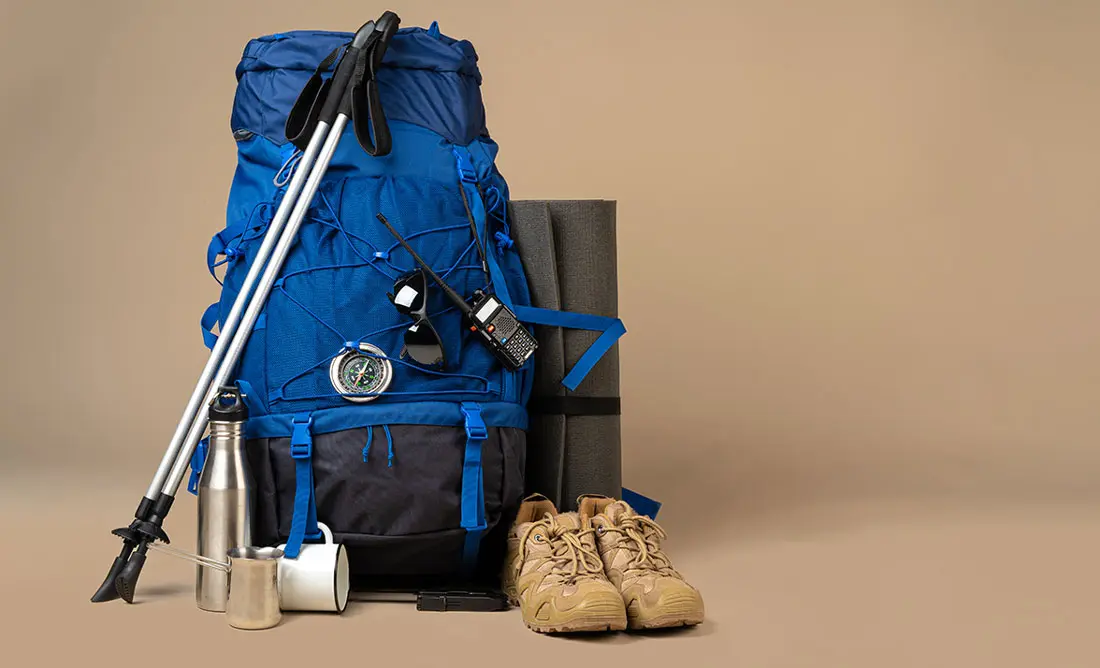
Frequently Asked Questions(FAQ)
To register with TTH, visit our website - www.trekthehimalayas.com and create your account. To create your account you will need to use your email address and fill in all the details, set your unique password and your account is ready to use.
- To book a trek with TTH, you first need to register with us and create an account.
- Choose the trek that you want to do and click on available dates.
- You will land at the login page, fill in the required details.
- Add Participants, choose add-on services click on the Pay now button, choose your preferred payment method, and make the payment. TTH accepts multiple payment options, including credit/debit cards, net banking, and UPI.
- You will receive a confirmation email from TTH with all the necessary details about the trek, including the meeting point, transportation, accommodation, and other important instructions.
- Click Here to watch Video
please send an email to us at info@trekthehimalayas.com or reach out to the numbers provided in the Help and Support section of your Trek Page. We will ensure that your issue is promptly resolved.
To book services such as off-load luggage and transportation, you can find them listed as add-ons. These additional services can be booked at the time of your initial booking. If you miss booking add-ons during the initial reservation, you can log in anytime and easily book 4 days before the departure date add-ons through the platform.
If you have booked the wrong trek or selected the wrong date, don’t worry! You can contact us at +91 9368882322 (Monday to Saturday, 10 AM to 10 PM) or email us at info@trekthehimalayas.com. You can also discuss this with your trek coordinator. Please make sure to inform us at least 10 days before the departure of your trek. Only then can we help you reschedule or arrange another trek for you.
We recommend visiting our "Suggest Me a Trek" page. By filling out the form, our experts will contact you with the best possible trek options based on your preferences and experience level. Alternatively, you can reach out to us via email at info@trekthehimalayas.com or give us a call using the numbers provided on our website for personalized assistance and recommendations.
Family treks differ from regular treks by focusing on ease of difficulty, offering shorter durations for younger participants, Kid-friendly and easily digestible foods, child-friendly activities, maintaining a higher guide ratio for diverse age groups, and implementing additional safety measures for families.
Family Trek with Kids recommendation Only Dayara Bugyal and Chopta Chandrashila Trek.
Minimum age for TTH treks is typically 7 years, though this may vary depending on the specific trek.
Yes, you can take a kids to a high-altitude trek with a parent. Discuss with a trek expert before booking a trek.
- Junior trekkers (below 15 years) should have a company of parents/guardians.
- Trekkers between 15 to 18 years can come solo with the disclaimer form signed by parent/guardian.
- Medical & Disclaimer Form (Mandatory Documents) Click here to download medical and disclaimer form
Physical Fitness: Ensure your child is physically fit. Engage them in regular exercise, outdoor activities, and hikes to build stamina and endurance. Hydration: Emphasize the importance of staying hydrated at high altitudes. Encourage your child to drink water regularly, even if they don't feel thirsty. Proper Nutrition: Provide a well-balanced diet with sufficient carbohydrates for energy and foods rich in iron to prevent altitude sickness. Adequate Sleep: Ensure your child gets enough sleep in the days leading up to the trek. Quality rest is crucial for altitude adaptation. Educate on Altitude Sickness: Teach your child about the symptoms of altitude sickness, such as headache, nausea, and dizziness. Encourage them to communicate any discomfort immediately. Appropriate Clothing and Gear: Dress your child in layers to adjust to changing temperatures. Ensure they have appropriate trekking gear, including sturdy footwear. Positive Mindset: Foster a positive mindset. Encourage your child, and let them know it's okay to take breaks when needed. Medical Check-Up: Schedule a medical check-up before the trek to ensure your child is fit for high-altitude activities. Consult with a healthcare professional about any potential health concerns.
TTH takes special care to provide wholesome and nutritious food for children on treks. Here are some of the foods that are typically served for children:
Breakfast: For breakfast, TTH serves a variety of options like porridge, cornflakes, bread, butter, jam, honey, boiled eggs, omelettes, and pancakes. Children can choose from these options to fuel themselves for the day's trek.
Lunch: For lunch, TTH serves lunch which includes rotis, vegetables, rice, dal, and salad. The rotis are usually made fresh on the trek and are a good source of carbohydrates. The dal and vegetables provide protein and other essential nutrients.
Snacks: TTH provides healthy snacks like fresh fruits, dry fruits, energy bars, cookies, and biscuits to keep the children energized throughout the day.
Dinner: For dinner, TTH serves a hot and wholesome meal which includes soup, rice, dal, vegetables, and a non-vegetarian dish (if requested in advance). Children can also choose from a variety of desserts like custard, jelly, and fruit salad.
Dietary requirements: If a child has any special dietary requirements, TTH can cater to those needs as well. For example, if a child is lactose intolerant or allergic to nuts, the kitchen staff can make arrangements to accommodate those requirements.
Choosing the right trek for a beginner can be a bit overwhelming as there are many factors to consider such as distance, elevation gain, terrain difficulty, weather, and time of year. Here are some tips that can help you choose the right trek for a beginner:
1. Determine fitness level: Assess the fitness level of the beginner to understand their physical capabilities. This will help you select a trek that is challenging but not too difficult.
2. Choose a well-traveled trail: A well-traveled trail will have more amenities such as signposts, water stations, and shelter. It is also safer as there will be other hikers on the trail.
3. Consider the length of the trek: For beginners, it is recommended to start with a shorter trek that can be completed in a day or two. This will help them get acclimatized to trekking and build their confidence.
4. Look for gradual elevation gain: Choose a trek with a gradual elevation gain rather than steep ascents. This will make the trek easier and more enjoyable.
5. Check the weather: Check the weather forecast before selecting a trek. Avoid treks during the monsoon season or winter when the trails can be slippery or dangerous.
6. Research the trail: Read about the trail to get an idea of the terrain, altitude, and difficulty level. This will help you select a trek that is suitable for the beginner.
7. Consult with an expert: If you are unsure about which trek to choose, consult our trek expert Mr. Nitin (+91 70600 59773) between 10 AM to 6 PM (Tuesday - Friday). Mr. Nitin will provide you valuable advice and guidance.
Overall, it is important to choose a trek that is enjoyable, challenging but not too difficult, and suitable for the beginner's fitness level and experience.
It is not recommended for a beginner to choose a difficult Himalayan trek. Trekking in the Himalayas can be physically and mentally challenging, especially if you are not used to the high altitude, steep slopes, and rugged terrain. Choosing a difficult trek without the proper experience, fitness level, and preparation can be dangerous and put you at risk of altitude sickness, injury, and other hazards.
If you are a beginner, it is recommended to start with an easier trek and gradually build up your skills and experience. This will help you understand the challenges of trekking in the Himalayas, and also prepare you physically and mentally for a more difficult trek in the future. It is also important to choose a trek that matches your fitness level, experience, and interest.
There is no specific age limit for a beginner trekker. However, it is important to consider your physical fitness, health condition, and personal interests before embarking on a trek. Trekking in the Himalayas can be physically and mentally demanding, and requires a certain level of physical fitness and endurance.
If you have any pre-existing medical conditions or are above a certain age, it is recommended to consult with a doctor before embarking on a trek. It is also important to listen to your body and take breaks as needed during the trek to prevent exhaustion or injury.
We recommend visiting our "Suggest Me a Trek" page. By filling out the form, our experts will contact you with the best possible trek options based on your preferences and experience level. Alternatively, you can reach out to us via email at info@trekthehimalayas.com or give us a call using the numbers provided on our website for personalized assistance and recommendations.
Yes, you can join the trek. We have fixed departure groups where you can simply book your trek and we will take care of curating a group.
Before you start the trek, it is recommended that you make all the necessary phone calls as during the trek you may or may not receive network coverage, once you come back to the Base Camp, you can reconnect with your family via phone once again. You can share your trek coordinator contact detail with your family members to get the latest updates about your trek batch.
At TTH, we provide wholesome and nutritious meals during the trek. The food is vegetarian and includes a variety of dishes such as rice, dal, vegetables, chapati, paratha, pasta, noodles, and soup. We also offer snacks such as biscuits, and salty, and dry fruits during the trek. Special dietary requirements such as vegan, gluten-free, or Jain food can also be arranged if informed in advance.
If you are allergic to some foods, you need to let us know in advance so that we can make arrangements accordingly.
TTH is a trekking company that prioritizes the safety of all its participants, including women trekkers. We have a comprehensive safety system in place, which includes a dedicated team of experienced and trained trek leaders and support staff who are equipped to handle emergency situations and provide first aid.
TTH also takes specific measures to ensure the safety and comfort of women trekkers. They have a separate tent accommodation for women trekkers, female trek leaders, and support staff. They also provide separate toilet facilities for women and encourage a safe and respectful environment for all trekkers.
Moreover, TTH has a strict policy against any kind of harassment and has a zero-tolerance policy towards such incidents. They have a designated Internal Complaints Committee (ICC) to investigate and address any complaints related to harassment or misconduct. Overall, TTH has a good reputation for safety and responsible trekking practices, and women can feel comfortable and safe while trekking with them.
In case you are the only women in the group, we provide a single sleeping arrangement. Also, during the trek, the trek leader will always remain by your side to provide optimum safety and reassurance.
You can reach out to the trek coordinator to inquire about the number of female trekkers and their respective states who have booked the trek. Please note that the trek coordinator cannot disclose personal details of any trekker. Once you've confirmed your booking, a WhatsApp Group will be created for all the trekkers in your batch. This allows you to connect with fellow trekkers before the trek begins.
While many of our treks are led by female trek leaders, however, it is not possible to know which trek leader is assigned to which group. But nonetheless, whether the trek leader is male or female you can be completely assured of your safety and security with us.
Yes, it is possible to trek with periods. However, it is important to take some extra precautions and preparations to ensure a comfortable and safe trekking experience. Here are some tips that can help you trek during your period:
1. Use menstrual hygiene products that you are comfortable with, such as tampons, pads, or menstrual cups. It is recommended to carry enough supplies for the entire duration of the trek.
2. Pack wet wipes, hand sanitizer, and plastic bags to dispose of used hygiene products.
3. Wear comfortable and breathable clothing that allows for easy movement and reduces friction. Avoid wearing tight or restrictive clothing that can cause discomfort.
4. Carry pain relief medication, such as ibuprofen or acetaminophen, in case of menstrual cramps.
5. Stay hydrated and maintain a balanced diet to support your energy levels and overall health.
6. Take breaks as needed and listen to your body. If you feel uncomfortable or experience any unusual symptoms, seek medical attention immediately. It is also recommended to consult with a doctor before going on a trek during your period, especially if you have a pre-existing medical condition or are taking medication.
By taking necessary precautions and being prepared, you can have a safe and comfortable trekking experience even during your period. We provide proper disposal facilities for sanitary pad disposal during the trek.
We offer three person tents with twin-sharing for optimum comfort. A woman trekker will share a tent with another woman trekker and if you are the only woman in the group, you will be given a single accommodation for your comfort and privacy.
Yes, we do provide gears on rent. You can book it using you TTH account directly.
Mountaineering qualified Experienced and first aid certified Trek Leader, First Aid Certify local guide, Cook, helpers and supporting staff.
People suffering from Bronchitis, Asthma, High blood pressure, Epilepsy (got faints), TB , Heart problem or on higher BMI side are strictly not allowed to go on any Himalayan trek. Apart from this if you had any medical history, please let us know.
No. Alcohol and smoking isn’t allowed while on trek. It is totally misconception that it will keep you warm. Your body need to acclimatize properly and for that eat properly and drink enough water; these things will keep you warm.
Toilet tents provide a convenient solution for answering nature's call in the great outdoors. Dry toilets, in particular, offer a highly sanitary approach. By digging a pit and utilizing mud and a shovel, you can easily cover up your waste. This method ensures cleanliness and hygiene while camping or exploring in the forest.
Remember to pack essential toiletries to complete your outdoor bathroom kit and maintain proper personal hygiene during your adventures. With these practices in place, you can enjoy nature while also respecting it.
Layer Up From Head To Toe
Eat Full Meals, never sleep empty stomach
You can keep warmee (if you’re more susceptible to cold).
Use sleeping bag in right way and don’t leave free space in sleeping bag.
For upper body
– Thermal layer
– T-shirt (full-sleeves)
– Fleece T-shirt (for extreme colds)
– Fleece layer
– Thick Jacket/Down Jacket
– Waterproof or Windproof layer (outermost layer, when it is snowing or raining)
- For Lower Body
– Thermal layer
– Hiking pants (normal) or Winter hiking pants
Based on how warm you feel you can skip any of the above layers. Your outer later should be windproof since it is windy at high altitude.
The idea behind layering is that the more insulation you have the less cold you feel, and instead of wearing a very thick jacket if you wear multiple layers, your body will be better insulated against the cold.
Yes, we provide micro spikes and gaiters, if required.
Mandatory documents: 2 xerox of ID having address (addhar card/driving license), 2 Passport size photographs, hard copy Medical form signed & sealed by doctor, disclaimer form sign by trekker and high altitude insurance.
No. We don’t but we can suggest you good hotel/Stay nearby pick up location.
Yes, trekker must carry 2 water bottles 1 litre each so they can refill it at campsite for drinking and keep themselves hydrate.
You should buy shoes which has these three features –Good grip, Ankle Support and additional water resistant layers. Generally, we advise Quechua Trek 100, MH 500 and MH 100.
No one is forced to go on. There is always enough staff to split the party according to need and regroup later at the camp. Most people have no trouble reaching the highest campsite. If some members decide not to climb the final distance they can wait for the climbers to come back down the same way or take a lateral path to the descent route.
- The Annapurna Base Camp Trek offers stunning views of the Annapurna range, Machapuchare, and other Himalayan peaks right from the start.
- Accommodation in classic teahouses run by locals adds a unique charm to the trekking experience.
- The trek passes through protected areas teeming with floral and faunal species.
- Immerse yourself in the rich traditions of the Gurung and Magar communities, and visit traditional villages along the trail.
- Relax and rejuvenate in the soothing geothermal waters of Jhinu Danda, surrounded by the beauty of the Annapurna region.
- The Annapurna Base Camp trek is suitable for individuals aged 12 years and above.
- While previous trekking experience is appreciated, first-timers are welcome to join.
- Participants should be physically fit, and able to cover 5 km in 30 minutes without stress.
Altitude sickness is a potential risk due to the trek's elevation, with Annapurna Base Camp situated at over 4,000 meters above sea level. To minimize the risk of altitude sickness, it's essential to acclimatize properly, stay hydrated, and ascend gradually. Trekkers should be aware of symptoms such as headache, nausea, dizziness, and difficulty breathing and inform their guide if they experience any discomfort.
Travel insurance is highly recommended for the Annapurna Base Camp Trek to cover unexpected medical emergencies, trip cancellations, and evacuation services. Ensure that your insurance policy includes coverage for high-altitude trekking and activities such as helicopter rescue if needed.
Accommodation during the Annapurna Base Camp Trek is primarily in teahouses or guesthouses along the trail. Teahouses offer basic but comfortable amenities, including dormitory-style or private rooms with shared bathrooms.
While it's possible to trek to Annapurna Base Camp independently, hiring an expert trekking company is highly recommended for safety, navigation, and cultural insights. The expert Trek Leaders and guides are familiar with the terrain, weather conditions, and emergency procedures, enhancing the overall trekking experience and minimizing risks.
The Annapurna Base Camp Trek requires a moderate level of fitness, with daily trekking durations ranging from 4 to 8 hours over varied terrain. Trekkers should be comfortable walking on uneven trails, ascending and descending steep sections, and carrying a daypack with essential items. Regular cardiovascular exercise and strength training prior to the trek can help improve endurance and reduce fatigue.
Many teahouses along the Annapurna Base Camp Trek route offer electricity charging facilities, either through solar power or generators. However, electricity availability may be limited or unreliable in remote areas, so it's advisable to carry a portable power bank or solar charger for backup.
Teahouses and lodges along the trekking route typically have basic restroom facilities, including squat toilets or pit toilets. It's advisable to carry your supply of toilet paper and hand sanitizer as restroom amenities can vary in cleanliness and availability.
The Annapurna Conservation Area is home to a diverse range of wildlife, including Himalayan tahr, musk deer, snow leopards, langur monkeys, and various species of birds. While encounters with larger mammals are rare, trekkers may spot smaller wildlife such as birds, butterflies, and marmots along the trail, especially in forested areas and alpine meadows.
.webp)
.webp)
.webp)
.webp)
.webp)
.webp)
.webp)
.webp)
